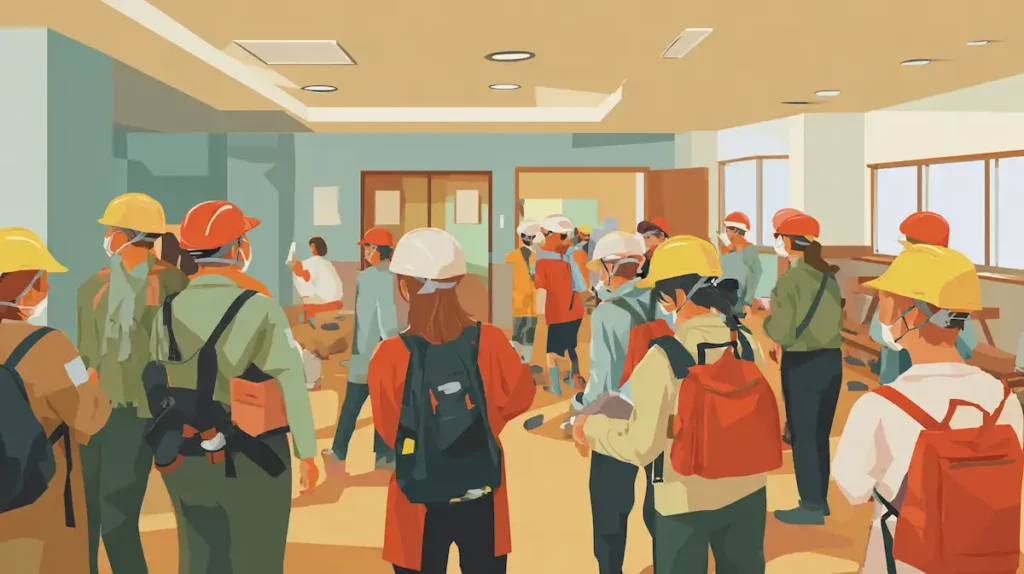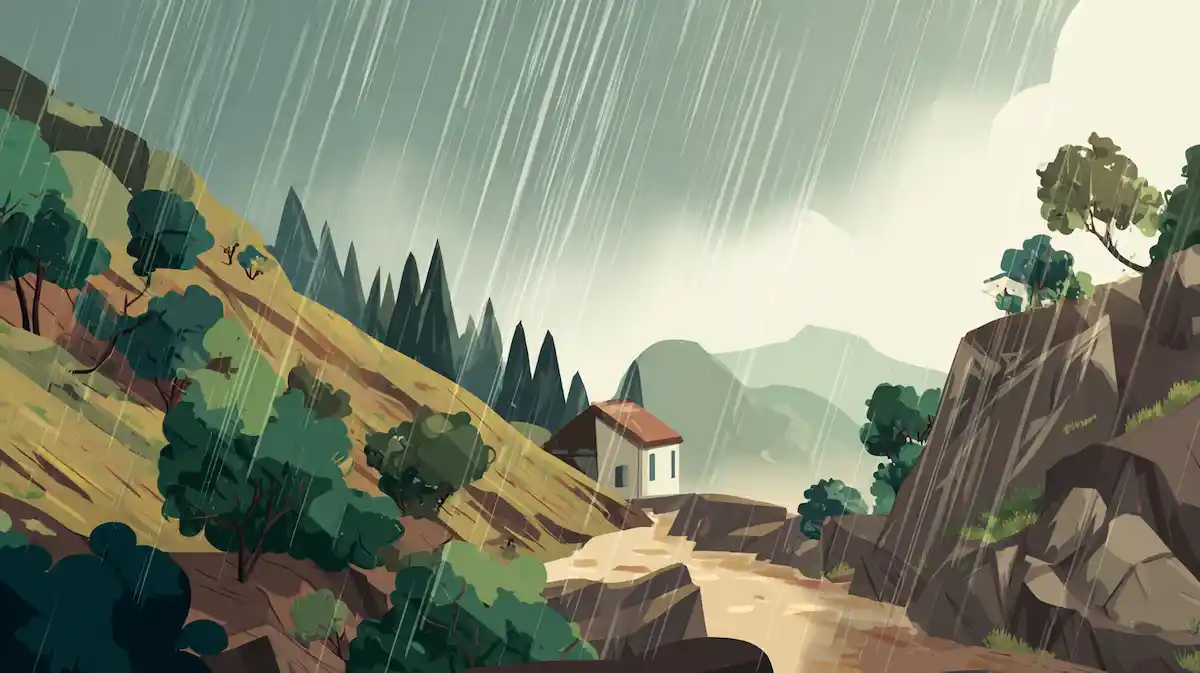日本の自然災害を英語で説明・紹介するための基本情報と、英会話に役立つ表現をシンプルでわかりやすい英語で紹介します。
英会話ダイアローグ・概要・10の質問を通して、日本の自然災害に関する英語表現を学びます。
英語
英会話ダイアローグを読む前に知っておくと良い前提知識と情報です。
- 日本の地理的特徴
- 日本列島は環太平洋造山帯に位置し、4つのプレートの境界にある
- 世界有数の地震多発地帯で、活火山も約110ある
- 世界の地震の約1割が日本周辺で発生
- 国土の約7割が山地で、川は短く急流が多く、雨が降ると洪水や土砂災害が起きやすい地形
- 主要な過去の災害
- 2011年東日本大震災はマグニチュード9.0の巨大地震で、最大40メートルの津波が発生
- 約2万人が犠牲になり、福島第一原発事故も引き起こした
- 日本の二大巨大災害リスク
- 南海トラフ(Nankai Trough):
- 駿河湾から九州沖にかけて海底にある深い溝(トラフ)のこと
- トラフ沿いのプレート境界で、過去100~150年間隔でマグニチュード8以上の巨大地震が繰り返し発生
- 今後30年以内に高い確率で巨大地震が発生すると予測されている
- 富士山(Mount Fuji):
- 日本を象徴する山、約300年前に噴火した活火山、常に監視体制が敷かれている
- 南海トラフ(Nankai Trough):
- 気候変動と新たな災害
- 近年、線状降水帯による記録的豪雨が増加
- 短時間で大量の雨が降り、土砂災害や河川氾濫を引き起こす
- 台風も大型化・強力化する傾向にある
- 防災
- 日本では、政府・自治体・地域・個人が連携して防災対策を行っている
- 「防災の日(9月1日)」など、日常的に意識を高める文化がある
- 建物は厳しい耐震基準に従い、学校や職場では定期的に避難訓練が実施される
2人が自然災害について話しています。
地震や台風、火山噴火など日本の主な災害の特徴、発生状況、防災対策、将来の予測などを話題にしています。
会話 / dialogue

Hey Key, I’ve been reading a lot about Japan’s natural disasters lately. It’s incredible how many different kinds happen here!

Yeah, Japan really is one of the most disaster-prone countries in the world. What made you interested in that?

Actually, last week I joined a disaster drill at my community center. It made me realize how important it is to understand the risks in Japan.

That’s great! Those drills are very useful. Japan has earthquakes, tsunamis, typhoons, heavy rain, landslides, volcanic eruptions, and even heavy snow.

Wow, that’s quite a list. Why do so many disasters happen here?

It’s mainly because of Japan’s geography. The country sits on the boundaries of four tectonic plates—the Pacific, Philippine Sea, Eurasian, and North American plates. That’s why earthquakes and volcanoes are frequent.

I see. So that’s also connected to Mount Fuji and the Nankai Trough, right?

Exactly. Mount Fuji is an active volcano, and experts keep monitoring it. The Nankai Trough, on the other hand, could cause a massive earthquake and tsunami in the future.

That sounds serious. Hasn’t Japan already experienced big ones before?

Yes, the 2011 Great East Japan Earthquake was one of the largest in history. It caused a huge tsunami and even a nuclear accident. It reminded everyone how powerful nature can be.

I remember seeing that on the news. It must have been terrifying. How does Japan prepare for such disasters now?

The government and local authorities have improved a lot since then. They have early warning systems, strict building codes, and public education programs. People also keep emergency kits at home.

I actually started preparing one! Water, food, flashlight, and batteries, right?

Exactly. The basic idea is to be able to survive for at least 72 hours after a disaster. That’s called the “three-day rule.”

Good to know! But what about local communities? Do they also take action?

Yes, communities organize neighborhood disaster groups. They check evacuation routes, help elderly people, and practice emergency drills together.

That’s really smart. Japan seems well-organized when it comes to disaster prevention.

True, but the challenges are still huge. Climate change is increasing heavy rainfall, typhoons, and floods. We now see more “linear rainbands” that cause record-breaking rain in a short time.

Oh yeah, I read about that. Some people call them “guerrilla heavy rain,” right?

Exactly! And they often cause landslides or flash floods, especially in mountainous areas. That’s why hazard maps are so important.

Where can people find those maps?

They’re available online or at local city offices. You can check whether your home is in a flood or landslide risk zone.

I should definitely check that. I didn’t realize how many factors make Japan vulnerable.

Yeah, but remember, Japan’s also strong in disaster technology. We have real-time alerts, earthquake-resistant buildings, and even apps for emergency information in multiple languages.

That’s impressive. So, even though we can’t stop natural disasters, we can reduce the damage, right?

Exactly. That’s what we call bōsai (disaster prevention) and gensai (damage reduction). Living in Japan means respecting nature and always being ready for its power.

Well said, Key. I think I’ll keep studying more about Japan’s disaster systems. It’s not just knowledge—it’s survival.

Good attitude, Mack. And remember—being prepared is the best way to protect yourself and others.
概要(日本の自然災害とは?特徴・防災対策・気候変動の影響)
「日本の自然災害」について、理解を深めるための「英語での概要」です。
日本の自然災害

Geography and Location
Japan is one of the most disaster-prone countries in the world. It is located on the borders of four tectonic plates — the Pacific, Philippine Sea, Eurasian, and North American plates. Because of this, the country experiences many earthquakes and volcanic eruptions. Japan also has many mountains and rivers with steep slopes, which makes floods and landslides more likely when it rains heavily.
Main Types of Disasters
The main natural disasters in Japan are earthquakes, tsunamis, typhoons, heavy rain, landslides, volcanic eruptions, and heavy snow. Earthquakes can happen anywhere and sometimes cause large tsunamis along the Pacific coast. In summer and autumn, typhoons bring strong winds and rain, often causing floods and damage to houses. In winter, people living on the Sea of Japan side experience heavy snowfall and avalanches.
Disaster Prevention and Preparedness
Japan has learned many lessons from past disasters, such as the 2011 Great East Japan Earthquake. The government and local communities work together to improve safety. There are early warning systems, strong building codes, and regular disaster drills. Many people in Japan keep emergency kits at home with food, water, and flashlights to survive for 72 hours after a disaster.
Future Challenges
Recently, climate change has made weather-related disasters more severe. Heavy rain, typhoons, and floods are happening more often. Japan continues to develop new technologies and educate people to reduce damage and protect lives. Living in Japan means being prepared and respecting the power of nature.
10の質問(日本の自然災害の基本知識)
「日本の自然災害」について、理解を深めるための「英語での10の質問」です。
1: What are the main natural disasters in Japan?
The main natural disasters in Japan are earthquakes, tsunamis, typhoons, heavy rain, landslides, volcanic eruptions, and heavy snow.
2: Why does Japan have so many earthquakes?
Japan lies on the borders of four tectonic plates, which often move and cause frequent earthquakes.
3: What was the most serious earthquake in recent Japanese history?
The 2011 Great East Japan Earthquake was one of the strongest in history. It caused a huge tsunami and great damage.
4: What kind of disasters are caused by heavy rain?
Heavy rain can cause floods and landslides, especially in mountainous areas with steep slopes.
5: When do typhoons usually hit Japan?
Typhoons usually come between summer and autumn, from July to October.
6: Is Mount Fuji still an active volcano?
Yes, Mount Fuji is an active volcano. Experts continue to monitor it carefully, although it has not erupted since 1707.
7: How does the Japanese government prepare for disasters?
The government has early warning systems, strict building codes, and organizes disaster drills to protect people’s lives.
8: What should people keep in their emergency kit?
People should keep food, water, a flashlight, batteries, and medicine to survive for at least 72 hours after a disaster.
9: How does climate change affect Japan’s natural disasters?
Climate change is making typhoons, heavy rain, and floods stronger and more frequent in Japan.
10: What is the main idea of disaster prevention in Japan?
The main idea is to be prepared and reduce damage through planning, education, and community cooperation.

和訳付
会話 / dialogue

Hey Key, I’ve been reading a lot about Japan’s natural disasters lately. It’s incredible how many different kinds happen here!
なあキー、最近日本の自然災害についてよく読んでるんだ。ここでこんなに多くの種類の災害が起こるなんて驚きだよ!

Yeah, Japan really is one of the most disaster-prone countries in the world. What made you interested in that?
うん、日本は世界でも特に災害が多い国のひとつだよ。どうして興味を持ったの?

Actually, last week I joined a disaster drill at my community center. It made me realize how important it is to understand the risks in Japan.
実は先週、地域センターの防災訓練に参加したんだ。それで、日本で災害のリスクを理解することがどれだけ大切か実感したんだよ。

That’s great! Those drills are very useful. Japan has earthquakes, tsunamis, typhoons, heavy rain, landslides, volcanic eruptions, and even heavy snow.
それはいいね!ああいう訓練ってすごく役に立つよ。日本では地震、津波、台風、大雨、土砂崩れ、火山の噴火、さらには大雪まであるからね。

Wow, that’s quite a list. Why do so many disasters happen here?
うわぁ、それは多いな。なんで日本ではこんなに災害が起こるの?

It’s mainly because of Japan’s geography. The country sits on the boundaries of four tectonic plates—the Pacific, Philippine Sea, Eurasian, and North American plates. That’s why earthquakes and volcanoes are frequent.
主な理由は日本の地理的な位置なんだ。日本は4つのプレートの境界にあるんだよ。太平洋、フィリピン海、ユーラシア、北アメリカのプレートね。だから地震や火山活動が多いんだ。

I see. So that’s also connected to Mount Fuji and the Nankai Trough, right?
なるほど。それって富士山とか南海トラフにも関係あるってこと?

Exactly. Mount Fuji is an active volcano, and experts keep monitoring it. The Nankai Trough, on the other hand, could cause a massive earthquake and tsunami in the future.
そのとおり。富士山は活火山だから、専門家が常に監視してるんだ。一方で南海トラフは、将来的に巨大地震や津波を引き起こす可能性があるんだよ。

That sounds serious. Hasn’t Japan already experienced big ones before?
それは深刻だね。日本って、これまでにも大きな地震を経験してるよね?

Yes, the 2011 Great East Japan Earthquake was one of the largest in history. It caused a huge tsunami and even a nuclear accident. It reminded everyone how powerful nature can be.
うん、2011年の東日本大震災は史上最大級の地震だったよ。巨大な津波と原発事故も起こって、自然の力のすごさを思い知らされたんだ。

I remember seeing that on the news. It must have been terrifying. How does Japan prepare for such disasters now?
ニュースで見たのを覚えてるよ。本当に恐ろしかったよね。今の日本は、そういう災害にどう備えてるの?

The government and local authorities have improved a lot since then. They have early warning systems, strict building codes, and public education programs. People also keep emergency kits at home.
あのとき以来、政府や自治体はずいぶん改善したよ。早期警報システムや厳しい建築基準、防災教育もあるし、家庭でも非常用の備えをしている人が多いんだ。

I actually started preparing one! Water, food, flashlight, and batteries, right?
僕も準備を始めたんだ!水と食料、懐中電灯と電池、だよね?

Exactly. The basic idea is to be able to survive for at least 72 hours after a disaster. That’s called the “three-day rule.”
そうそう。災害後の72時間を自力で生き延びるのが基本なんだ。それを“三日間ルール”って言うんだよ。

Good to know! But what about local communities? Do they also take action?
なるほど!でも地域コミュニティではどんなことをしてるの?

Yes, communities organize neighborhood disaster groups. They check evacuation routes, help elderly people, and practice emergency drills together.
地域では防災グループを作って、避難経路を確認したり、高齢者を助けたり、一緒に避難訓練をしたりしてるよ。

That’s really smart. Japan seems well-organized when it comes to disaster prevention.
それはすごいね。日本は防災に関して本当にしっかりしてるんだね。

True, but the challenges are still huge. Climate change is increasing heavy rainfall, typhoons, and floods. We now see more “linear rainbands” that cause record-breaking rain in a short time.
確かにそうだけど、課題もまだ多いよ。気候変動のせいで豪雨や台風、洪水が増えてるんだ。最近は“線状降水帯”っていう短時間に記録的な雨を降らせる現象もよく起きてる。

Oh yeah, I read about that. Some people call them “guerrilla heavy rain,” right?
ああ、それ読んだことある!“ゲリラ豪雨”って呼ばれてるやつだよね?

Exactly! And they often cause landslides or flash floods, especially in mountainous areas. That’s why hazard maps are so important.
その通り!特に山間部では土砂崩れや急な洪水を引き起こすこともあるんだ。だからハザードマップがすごく大事なんだよ。

Where can people find those maps?
そのハザードマップって、どこで見られるの?

They’re available online or at local city offices. You can check whether your home is in a flood or landslide risk zone.
インターネットや市役所で見られるよ。自分の家が洪水とか土砂災害の危険区域にあるかどうか確認できるんだ。

I should definitely check that. I didn’t realize how many factors make Japan vulnerable.
それは絶対に確認しなきゃね。日本がこんなに多くのリスクを抱えてるなんて知らなかったよ。

Yeah, but remember, Japan’s also strong in disaster technology. We have real-time alerts, earthquake-resistant buildings, and even apps for emergency information in multiple languages.
そうだね。でも日本は防災技術でも強いんだよ。リアルタイムの警報、耐震建築、多言語対応の防災アプリまであるんだ。

That’s impressive. So, even though we can’t stop natural disasters, we can reduce the damage, right?
すごいね。つまり、自然災害を止めることはできなくても、被害を減らすことはできるってことだよね?

Exactly. That’s what we call bōsai (disaster prevention) and gensai (damage reduction). Living in Japan means respecting nature and always being ready for its power.
その通り。それが“防災”と“減災”って言う考え方なんだ。日本で暮らすっていうのは、自然を敬って、その力に備えるってことなんだよ。

Well said, Key. I think I’ll keep studying more about Japan’s disaster systems. It’s not just knowledge—it’s survival.
いいこと言うね、キー。僕も日本の防災システムについてもっと勉強しようと思うよ。知識ってだけじゃなくて、生きるための力だね。

Good attitude, Mack. And remember—being prepared is the best way to protect yourself and others.
その意識は大事だよ、マック。そして覚えておいて——備えることが、自分や人を守る一番の方法なんだ。
概要(日本の自然災害とは?特徴・防災対策・気候変動の影響)
日本の自然災害

Geography and Location
Japan is one of the most disaster-prone countries in the world. It is located on the borders of four tectonic plates — the Pacific, Philippine Sea, Eurasian, and North American plates. Because of this, the country experiences many earthquakes and volcanic eruptions. Japan also has many mountains and rivers with steep slopes, which makes floods and landslides more likely when it rains heavily.
日本は、世界でも特に自然災害が多い国のひとつです。国土は4つのプレート(太平洋、フィリピン海、ユーラシア、北アメリカ)の境界に位置しており、そのため地震や火山の噴火が多く発生します。また、山地が多く川の傾斜も急なため、大雨が降ると洪水や土砂崩れが起こりやすい地形です。
Main Types of Disasters
The main natural disasters in Japan are earthquakes, tsunamis, typhoons, heavy rain, landslides, volcanic eruptions, and heavy snow. Earthquakes can happen anywhere and sometimes cause large tsunamis along the Pacific coast. In summer and autumn, typhoons bring strong winds and rain, often causing floods and damage to houses. In winter, people living on the Sea of Japan side experience heavy snowfall and avalanches.
日本で主に発生する自然災害には、地震、津波、台風、大雨、土砂崩れ、火山噴火、そして大雪があります。地震は日本のどこでも起こる可能性があり、太平洋側では大きな津波を引き起こすこともあります。夏から秋にかけては台風が強風と豪雨をもたらし、洪水や住宅被害が発生します。冬には日本海側で大雪や雪崩が頻繁に起こります。
Disaster Prevention and Preparedness
Japan has learned many lessons from past disasters, such as the 2011 Great East Japan Earthquake. The government and local communities work together to improve safety. There are early warning systems, strong building codes, and regular disaster drills. Many people in Japan keep emergency kits at home with food, water, and flashlights to survive for 72 hours after a disaster.
日本は、2011年の東日本大震災など、過去の災害から多くの教訓を学んできました。政府と地域社会が協力して安全性を高める取り組みを進めています。早期警報システムや厳しい建築基準、定期的な防災訓練などが整備されています。多くの人々は、災害後72時間を自力で生き延びるために、食料や水、懐中電灯などを入れた非常用袋を家庭に備えています。
Future Challenges
Recently, climate change has made weather-related disasters more severe. Heavy rain, typhoons, and floods are happening more often. Japan continues to develop new technologies and educate people to reduce damage and protect lives. Living in Japan means being prepared and respecting the power of nature.
近年、気候変動の影響で気象災害がより深刻になっています。大雨や台風、洪水の発生回数が増えており、その被害も拡大しています。日本は被害を減らし命を守るために、新しい技術の開発や防災教育を進めています。日本で暮らすということは、自然の力を尊重し、常に備えておくことを意味しています。
10の質問(日本の自然災害の基本知識)
1: What are the main natural disasters in Japan?
日本では主にどのような自然災害が発生しますか?
The main natural disasters in Japan are earthquakes, tsunamis, typhoons, heavy rain, landslides, volcanic eruptions, and heavy snow.
日本で主に発生する自然災害は、地震、津波、台風、大雨、土砂崩れ、火山噴火、そして大雪です。
2: Why does Japan have so many earthquakes?
なぜ日本では地震が多いのですか?
Japan lies on the borders of four tectonic plates, which often move and cause frequent earthquakes.
日本は4つのプレートの境界に位置しており、それらが動くことで頻繁に地震が発生します。
3: What was the most serious earthquake in recent Japanese history?
近年の日本で最も深刻だった地震は何ですか?
The 2011 Great East Japan Earthquake was one of the strongest in history. It caused a huge tsunami and great damage.
2011年の東日本大震災は歴史上最大級の地震の一つで、巨大な津波と甚大な被害をもたらしました。
4: What kind of disasters are caused by heavy rain?
大雨によってどのような災害が起こりますか?
Heavy rain can cause floods and landslides, especially in mountainous areas with steep slopes.
大雨は、特に傾斜の急な山間部で、洪水や土砂崩れを引き起こすことがあります。
5: When do typhoons usually hit Japan?
台風は通常いつ日本に上陸しますか?
Typhoons usually come between summer and autumn, from July to October.
台風は通常、夏から秋にかけて、7月から10月の間に日本にやってきます。
6: Is Mount Fuji still an active volcano?
富士山は今も活火山ですか?
Yes, Mount Fuji is an active volcano. Experts continue to monitor it carefully, although it has not erupted since 1707.
はい、富士山は現在も活火山です。1707年の噴火以降は活動していませんが、専門家が継続的に監視しています。
7: How does the Japanese government prepare for disasters?
日本政府は災害にどのように備えていますか?
The government has early warning systems, strict building codes, and organizes disaster drills to protect people’s lives.
政府は、早期警報システムや厳しい建築基準を整え、人々の命を守るために防災訓練を実施しています。
8: What should people keep in their emergency kit?
非常用袋には何を入れておくべきですか?
People should keep food, water, a flashlight, batteries, and medicine to survive for at least 72 hours after a disaster.
災害後72時間を生き延びるために、食料、水、懐中電灯、電池、薬などを非常用袋に備えておく必要があります。
9: How does climate change affect Japan’s natural disasters?
気候変動は日本の自然災害にどのような影響を与えていますか?
Climate change is making typhoons, heavy rain, and floods stronger and more frequent in Japan.
気候変動によって、日本では台風や大雨、洪水がより強く、頻繁に発生するようになっています。
10: What is the main idea of disaster prevention in Japan?
日本の防災の基本的な考え方は何ですか?
The main idea is to be prepared and reduce damage through planning, education, and community cooperation.
防災の基本的な考え方は、計画・教育・地域の協力を通して、常に備え、被害を減らすことです。

words & phrases
英会話ダイアローグと関連情報に出てきた単語・フレーズです(例文は各3つ)。

drill : 名詞 /drɪl/
意味: 訓練、練習。A practice or training exercise to prepare for an emergency or task.
(防災訓練としての「disaster drill(防災訓練)」を指す)
例文:
- We had a disaster drill at school last week.
「先週、学校で防災訓練がありました。」 - The fire drill helped students learn how to evacuate safely.
「火災訓練で、生徒たちは安全な避難方法を学びました。」 - People in Japan often join earthquake drills to be prepared.
「日本では、地震に備えて防災訓練に参加する人が多いです。」
landslide : 名詞 /ˈlænd.slaɪd/
意味: 土砂崩れ。A mass of earth, rock, and debris that moves down a slope.
(大雨や地震などで発生する「土砂災害」の一種として登場)
例文:
- Heavy rain caused a landslide in the mountain area.
「大雨で山間部に土砂崩れが発生しました。」 - Many houses were damaged by the landslide.
「多くの家がその土砂崩れで被害を受けました。」 - Roads were closed due to the risk of landslides.
「土砂崩れの危険があるため、道路が通行止めになりました。」
prevention : 名詞 /prɪˈven.ʃən/
意味: 予防、防止。The act of stopping something from happening or getting worse.
(「disaster prevention=防災」として、災害を未然に防ぐ取り組みを指す)
例文:
- Disaster prevention is an important part of Japanese culture.
「防災は日本文化の重要な一部です。」 - The government promotes disease prevention through education.
「政府は教育を通じて病気の予防を進めています。」 - Regular drills help in the prevention of serious accidents.
「定期的な訓練は重大な事故の防止に役立ちます。」
linear : 形容詞 /ˈlɪn.i.ər/
意味: 線状の、直線的な。Formed or arranged in a line.
(「linear rainband=線状降水帯」という気象現象の説明で登場)
例文:
- A linear rainband can bring record-breaking rainfall in a short time.
「線状降水帯は短時間で記録的な豪雨をもたらすことがあります。」 - The road runs in a linear direction across the valley.
「その道路は谷を横切るように直線的に走っています。」 - The data shows a linear increase in temperature over time.
「データは時間とともに気温が直線的に上昇していることを示しています。」
vulnerable : 形容詞 /ˈvʌl.nər.ə.bəl/
意味: 傷つきやすい、被害を受けやすい。Easily harmed, damaged, or affected.
(日本が地理的・気候的に「災害に脆弱である」という意味で使用)
例文:
- Japan is vulnerable to earthquakes and typhoons.
「日本は地震や台風に対して脆弱です。」 - Older people are more vulnerable to heat and illness.
「高齢者は暑さや病気にかかりやすいです。」 - Low-lying coastal areas are vulnerable to flooding.
「低地の沿岸地域は洪水の被害を受けやすいです。」
